MGMT 20135: Analyzing the Impact of Language on Critical Thinking
VerifiedAdded on 2023/06/09
|9
|2220
|114
Report
AI Summary
This report analyzes the research conducted by Manalo and Sheppard (2016) on the impact of language on critical thinking performance, particularly focusing on non-Western students. The study examines how language proficiency and structural limitations of the first language affect students' ability to perform critical evaluations. The report reviews the methodology, findings, and limitations of the research, including comparisons between Japanese and English-speaking students. It explores how cognitive abilities, perceptions, and teacher influence also play a role in critical thinking. The report also delves into the research's implications for future studies and the challenges faced by students in data interpretation and evaluation, as well as the importance of cognitive development and language proficiency. The research emphasizes the need for understanding how language proficiency, cognitive aspects and different language structures impact the critical thinking of students.
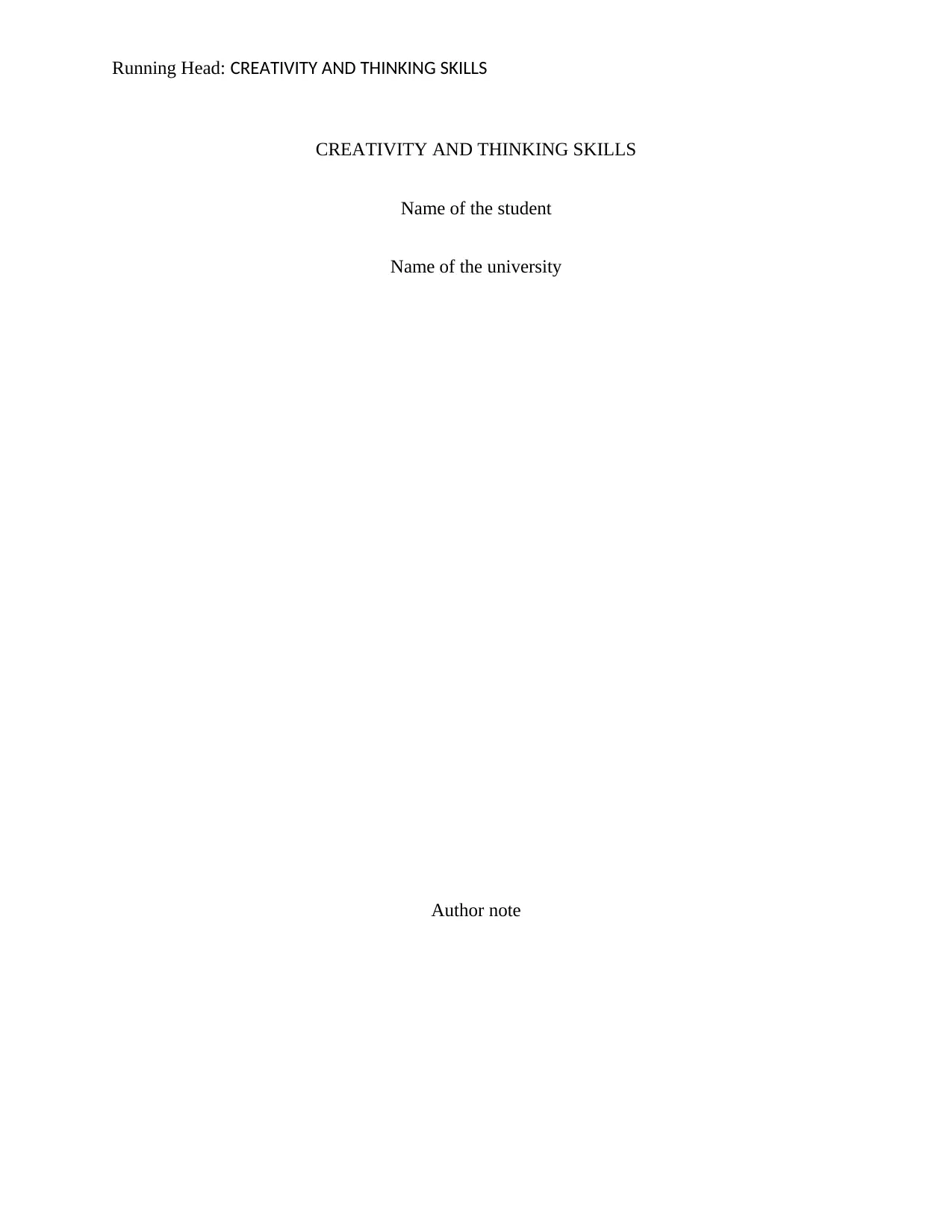
Running Head: CREATIVITY AND THINKING SKILLS
CREATIVITY AND THINKING SKILLS
Name of the student
Name of the university
Author note
CREATIVITY AND THINKING SKILLS
Name of the student
Name of the university
Author note
Paraphrase This Document
Need a fresh take? Get an instant paraphrase of this document with our AI Paraphraser
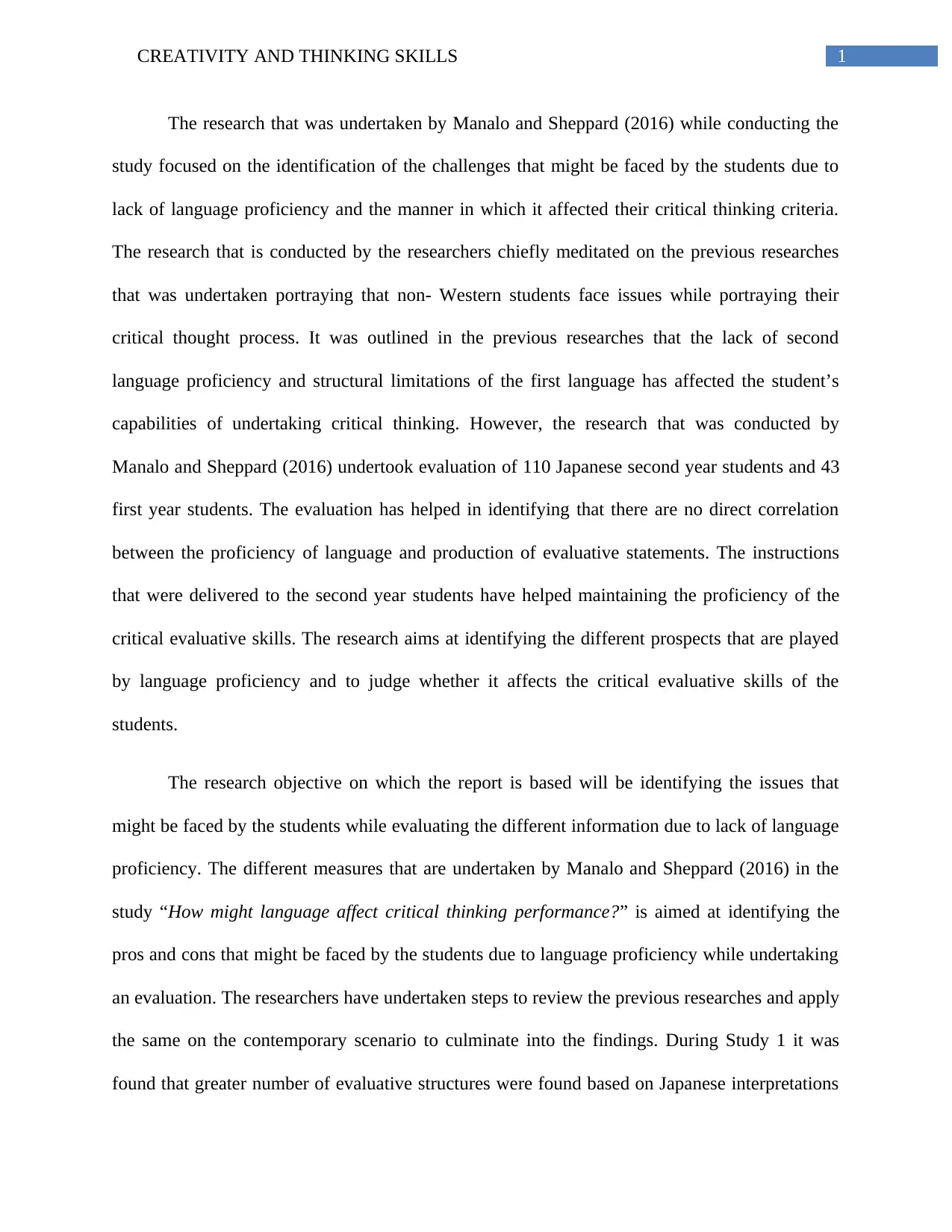
1CREATIVITY AND THINKING SKILLS
The research that was undertaken by Manalo and Sheppard (2016) while conducting the
study focused on the identification of the challenges that might be faced by the students due to
lack of language proficiency and the manner in which it affected their critical thinking criteria.
The research that is conducted by the researchers chiefly meditated on the previous researches
that was undertaken portraying that non- Western students face issues while portraying their
critical thought process. It was outlined in the previous researches that the lack of second
language proficiency and structural limitations of the first language has affected the student’s
capabilities of undertaking critical thinking. However, the research that was conducted by
Manalo and Sheppard (2016) undertook evaluation of 110 Japanese second year students and 43
first year students. The evaluation has helped in identifying that there are no direct correlation
between the proficiency of language and production of evaluative statements. The instructions
that were delivered to the second year students have helped maintaining the proficiency of the
critical evaluative skills. The research aims at identifying the different prospects that are played
by language proficiency and to judge whether it affects the critical evaluative skills of the
students.
The research objective on which the report is based will be identifying the issues that
might be faced by the students while evaluating the different information due to lack of language
proficiency. The different measures that are undertaken by Manalo and Sheppard (2016) in the
study “How might language affect critical thinking performance?” is aimed at identifying the
pros and cons that might be faced by the students due to language proficiency while undertaking
an evaluation. The researchers have undertaken steps to review the previous researches and apply
the same on the contemporary scenario to culminate into the findings. During Study 1 it was
found that greater number of evaluative structures were found based on Japanese interpretations
The research that was undertaken by Manalo and Sheppard (2016) while conducting the
study focused on the identification of the challenges that might be faced by the students due to
lack of language proficiency and the manner in which it affected their critical thinking criteria.
The research that is conducted by the researchers chiefly meditated on the previous researches
that was undertaken portraying that non- Western students face issues while portraying their
critical thought process. It was outlined in the previous researches that the lack of second
language proficiency and structural limitations of the first language has affected the student’s
capabilities of undertaking critical thinking. However, the research that was conducted by
Manalo and Sheppard (2016) undertook evaluation of 110 Japanese second year students and 43
first year students. The evaluation has helped in identifying that there are no direct correlation
between the proficiency of language and production of evaluative statements. The instructions
that were delivered to the second year students have helped maintaining the proficiency of the
critical evaluative skills. The research aims at identifying the different prospects that are played
by language proficiency and to judge whether it affects the critical evaluative skills of the
students.
The research objective on which the report is based will be identifying the issues that
might be faced by the students while evaluating the different information due to lack of language
proficiency. The different measures that are undertaken by Manalo and Sheppard (2016) in the
study “How might language affect critical thinking performance?” is aimed at identifying the
pros and cons that might be faced by the students due to language proficiency while undertaking
an evaluation. The researchers have undertaken steps to review the previous researches and apply
the same on the contemporary scenario to culminate into the findings. During Study 1 it was
found that greater number of evaluative structures were found based on Japanese interpretations
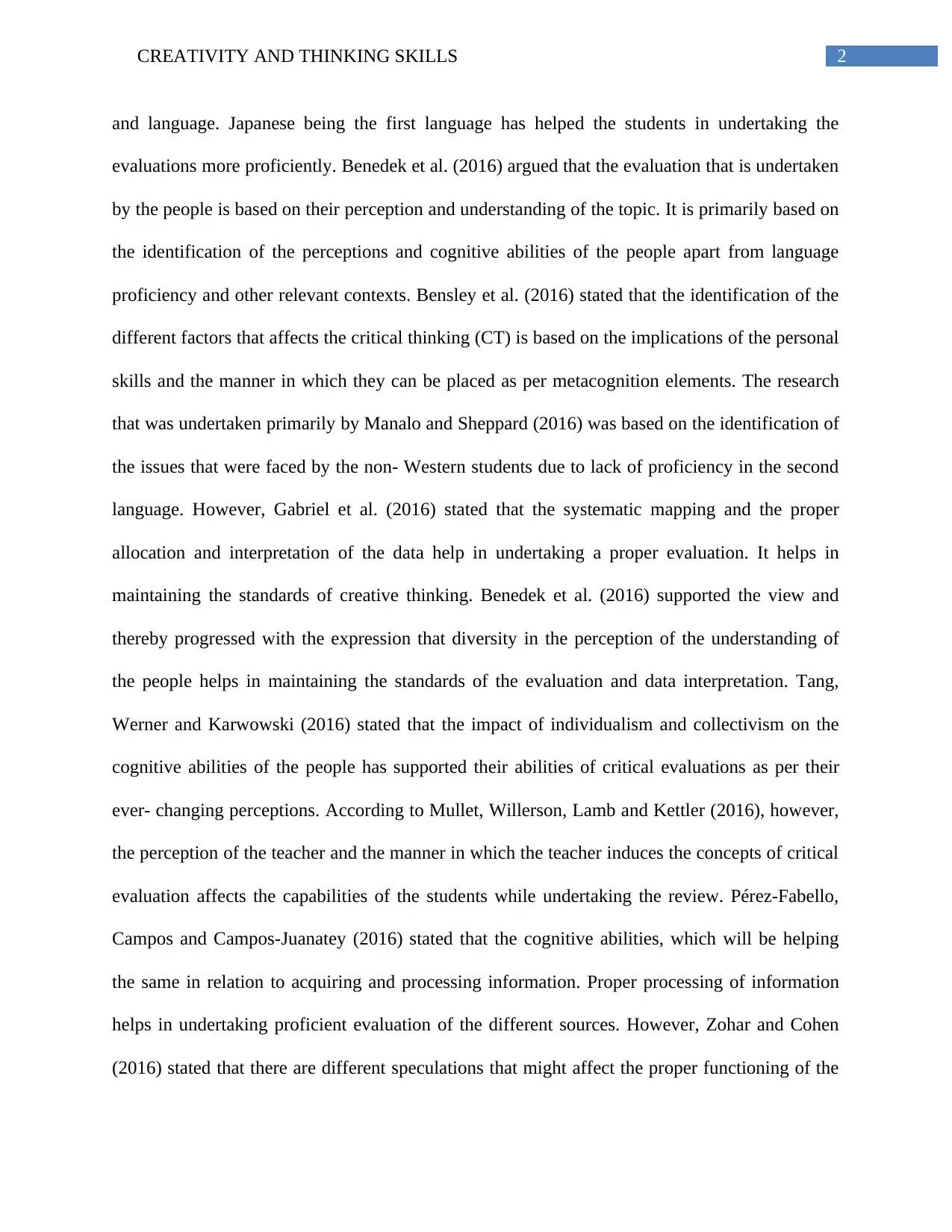
2CREATIVITY AND THINKING SKILLS
and language. Japanese being the first language has helped the students in undertaking the
evaluations more proficiently. Benedek et al. (2016) argued that the evaluation that is undertaken
by the people is based on their perception and understanding of the topic. It is primarily based on
the identification of the perceptions and cognitive abilities of the people apart from language
proficiency and other relevant contexts. Bensley et al. (2016) stated that the identification of the
different factors that affects the critical thinking (CT) is based on the implications of the personal
skills and the manner in which they can be placed as per metacognition elements. The research
that was undertaken primarily by Manalo and Sheppard (2016) was based on the identification of
the issues that were faced by the non- Western students due to lack of proficiency in the second
language. However, Gabriel et al. (2016) stated that the systematic mapping and the proper
allocation and interpretation of the data help in undertaking a proper evaluation. It helps in
maintaining the standards of creative thinking. Benedek et al. (2016) supported the view and
thereby progressed with the expression that diversity in the perception of the understanding of
the people helps in maintaining the standards of the evaluation and data interpretation. Tang,
Werner and Karwowski (2016) stated that the impact of individualism and collectivism on the
cognitive abilities of the people has supported their abilities of critical evaluations as per their
ever- changing perceptions. According to Mullet, Willerson, Lamb and Kettler (2016), however,
the perception of the teacher and the manner in which the teacher induces the concepts of critical
evaluation affects the capabilities of the students while undertaking the review. Pérez-Fabello,
Campos and Campos-Juanatey (2016) stated that the cognitive abilities, which will be helping
the same in relation to acquiring and processing information. Proper processing of information
helps in undertaking proficient evaluation of the different sources. However, Zohar and Cohen
(2016) stated that there are different speculations that might affect the proper functioning of the
and language. Japanese being the first language has helped the students in undertaking the
evaluations more proficiently. Benedek et al. (2016) argued that the evaluation that is undertaken
by the people is based on their perception and understanding of the topic. It is primarily based on
the identification of the perceptions and cognitive abilities of the people apart from language
proficiency and other relevant contexts. Bensley et al. (2016) stated that the identification of the
different factors that affects the critical thinking (CT) is based on the implications of the personal
skills and the manner in which they can be placed as per metacognition elements. The research
that was undertaken primarily by Manalo and Sheppard (2016) was based on the identification of
the issues that were faced by the non- Western students due to lack of proficiency in the second
language. However, Gabriel et al. (2016) stated that the systematic mapping and the proper
allocation and interpretation of the data help in undertaking a proper evaluation. It helps in
maintaining the standards of creative thinking. Benedek et al. (2016) supported the view and
thereby progressed with the expression that diversity in the perception of the understanding of
the people helps in maintaining the standards of the evaluation and data interpretation. Tang,
Werner and Karwowski (2016) stated that the impact of individualism and collectivism on the
cognitive abilities of the people has supported their abilities of critical evaluations as per their
ever- changing perceptions. According to Mullet, Willerson, Lamb and Kettler (2016), however,
the perception of the teacher and the manner in which the teacher induces the concepts of critical
evaluation affects the capabilities of the students while undertaking the review. Pérez-Fabello,
Campos and Campos-Juanatey (2016) stated that the cognitive abilities, which will be helping
the same in relation to acquiring and processing information. Proper processing of information
helps in undertaking proficient evaluation of the different sources. However, Zohar and Cohen
(2016) stated that there are different speculations that might affect the proper functioning of the
⊘ This is a preview!⊘
Do you want full access?
Subscribe today to unlock all pages.

Trusted by 1+ million students worldwide
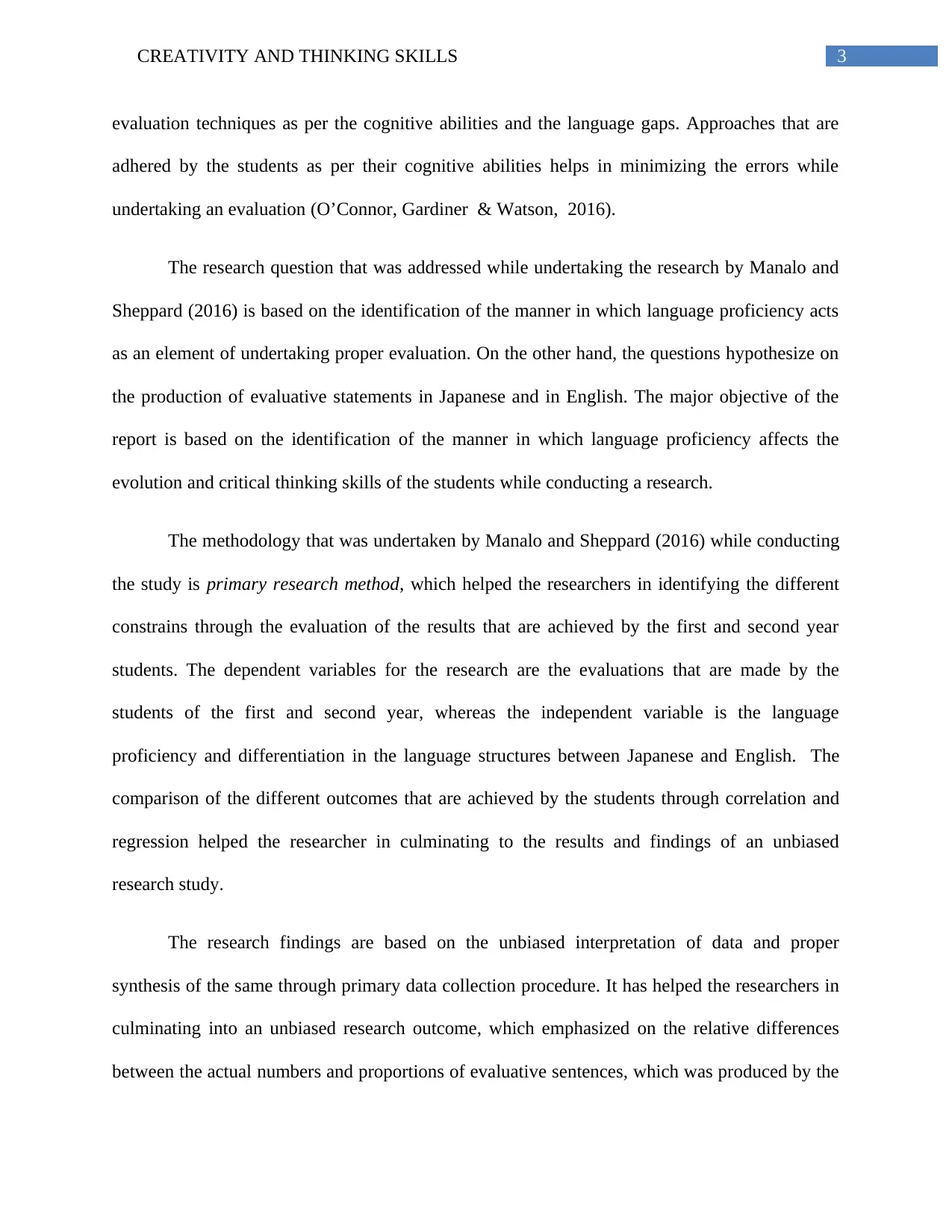
3CREATIVITY AND THINKING SKILLS
evaluation techniques as per the cognitive abilities and the language gaps. Approaches that are
adhered by the students as per their cognitive abilities helps in minimizing the errors while
undertaking an evaluation (O’Connor, Gardiner & Watson, 2016).
The research question that was addressed while undertaking the research by Manalo and
Sheppard (2016) is based on the identification of the manner in which language proficiency acts
as an element of undertaking proper evaluation. On the other hand, the questions hypothesize on
the production of evaluative statements in Japanese and in English. The major objective of the
report is based on the identification of the manner in which language proficiency affects the
evolution and critical thinking skills of the students while conducting a research.
The methodology that was undertaken by Manalo and Sheppard (2016) while conducting
the study is primary research method, which helped the researchers in identifying the different
constrains through the evaluation of the results that are achieved by the first and second year
students. The dependent variables for the research are the evaluations that are made by the
students of the first and second year, whereas the independent variable is the language
proficiency and differentiation in the language structures between Japanese and English. The
comparison of the different outcomes that are achieved by the students through correlation and
regression helped the researcher in culminating to the results and findings of an unbiased
research study.
The research findings are based on the unbiased interpretation of data and proper
synthesis of the same through primary data collection procedure. It has helped the researchers in
culminating into an unbiased research outcome, which emphasized on the relative differences
between the actual numbers and proportions of evaluative sentences, which was produced by the
evaluation techniques as per the cognitive abilities and the language gaps. Approaches that are
adhered by the students as per their cognitive abilities helps in minimizing the errors while
undertaking an evaluation (O’Connor, Gardiner & Watson, 2016).
The research question that was addressed while undertaking the research by Manalo and
Sheppard (2016) is based on the identification of the manner in which language proficiency acts
as an element of undertaking proper evaluation. On the other hand, the questions hypothesize on
the production of evaluative statements in Japanese and in English. The major objective of the
report is based on the identification of the manner in which language proficiency affects the
evolution and critical thinking skills of the students while conducting a research.
The methodology that was undertaken by Manalo and Sheppard (2016) while conducting
the study is primary research method, which helped the researchers in identifying the different
constrains through the evaluation of the results that are achieved by the first and second year
students. The dependent variables for the research are the evaluations that are made by the
students of the first and second year, whereas the independent variable is the language
proficiency and differentiation in the language structures between Japanese and English. The
comparison of the different outcomes that are achieved by the students through correlation and
regression helped the researcher in culminating to the results and findings of an unbiased
research study.
The research findings are based on the unbiased interpretation of data and proper
synthesis of the same through primary data collection procedure. It has helped the researchers in
culminating into an unbiased research outcome, which emphasized on the relative differences
between the actual numbers and proportions of evaluative sentences, which was produced by the
Paraphrase This Document
Need a fresh take? Get an instant paraphrase of this document with our AI Paraphraser

4CREATIVITY AND THINKING SKILLS
students of the first, and the second year in English and Japanese. The research undertaken by
Manalo and Sheppard (2016) focused on the identification of the diverse ways through which the
language differences and structure affects data interpretation and evaluation undertaken by the
students. The findings portrayed that the issues faced by the non- western students while
evaluating English is affected through the cognitive and perceptual transitions.
The findings of the research will be helping to identify one chief constrain that are faced
by the non- western students while evaluating and interpreting information that is made available
to them. As per Yang and Yang (2016), the cognitive aspects of data interpretation and
identification of the major context affects the data evaluation process that is undertaken by the
non- western students. It affects the critical thinking aspects of the students, which creates a gap
between the data that is being presented and the manner in which it is interpreted. The findings
of the research will be helping the future researchers in making a comparison between the
different issues that are faced by the students while undertaking an evaluation and thereby
formulate different strategies for mitigating the same. The acclaimed research will also be
helping the future researchers in identifying the different prospects of undertaking the study and
thereby work on the research limitations to identify the different other issues that are likely to
affect the evaluation process.
I believe that the research lacks in portraying all the relevant aspects other than language
proficiency, which affects the critical thinking skills of the students. As per Vezzali et al. (2016),
cognitive development and the evaluation skills of the students adds to the efficiency of the
researcher while conducting an evaluation- based study. However, Manalo and Sheppard (2016)
did not mention the different other elements that might affect the proper dissemination and
evaluation of the study that they might be undertaking. On the other hand, the researcher
students of the first, and the second year in English and Japanese. The research undertaken by
Manalo and Sheppard (2016) focused on the identification of the diverse ways through which the
language differences and structure affects data interpretation and evaluation undertaken by the
students. The findings portrayed that the issues faced by the non- western students while
evaluating English is affected through the cognitive and perceptual transitions.
The findings of the research will be helping to identify one chief constrain that are faced
by the non- western students while evaluating and interpreting information that is made available
to them. As per Yang and Yang (2016), the cognitive aspects of data interpretation and
identification of the major context affects the data evaluation process that is undertaken by the
non- western students. It affects the critical thinking aspects of the students, which creates a gap
between the data that is being presented and the manner in which it is interpreted. The findings
of the research will be helping the future researchers in making a comparison between the
different issues that are faced by the students while undertaking an evaluation and thereby
formulate different strategies for mitigating the same. The acclaimed research will also be
helping the future researchers in identifying the different prospects of undertaking the study and
thereby work on the research limitations to identify the different other issues that are likely to
affect the evaluation process.
I believe that the research lacks in portraying all the relevant aspects other than language
proficiency, which affects the critical thinking skills of the students. As per Vezzali et al. (2016),
cognitive development and the evaluation skills of the students adds to the efficiency of the
researcher while conducting an evaluation- based study. However, Manalo and Sheppard (2016)
did not mention the different other elements that might affect the proper dissemination and
evaluation of the study that they might be undertaking. On the other hand, the researcher
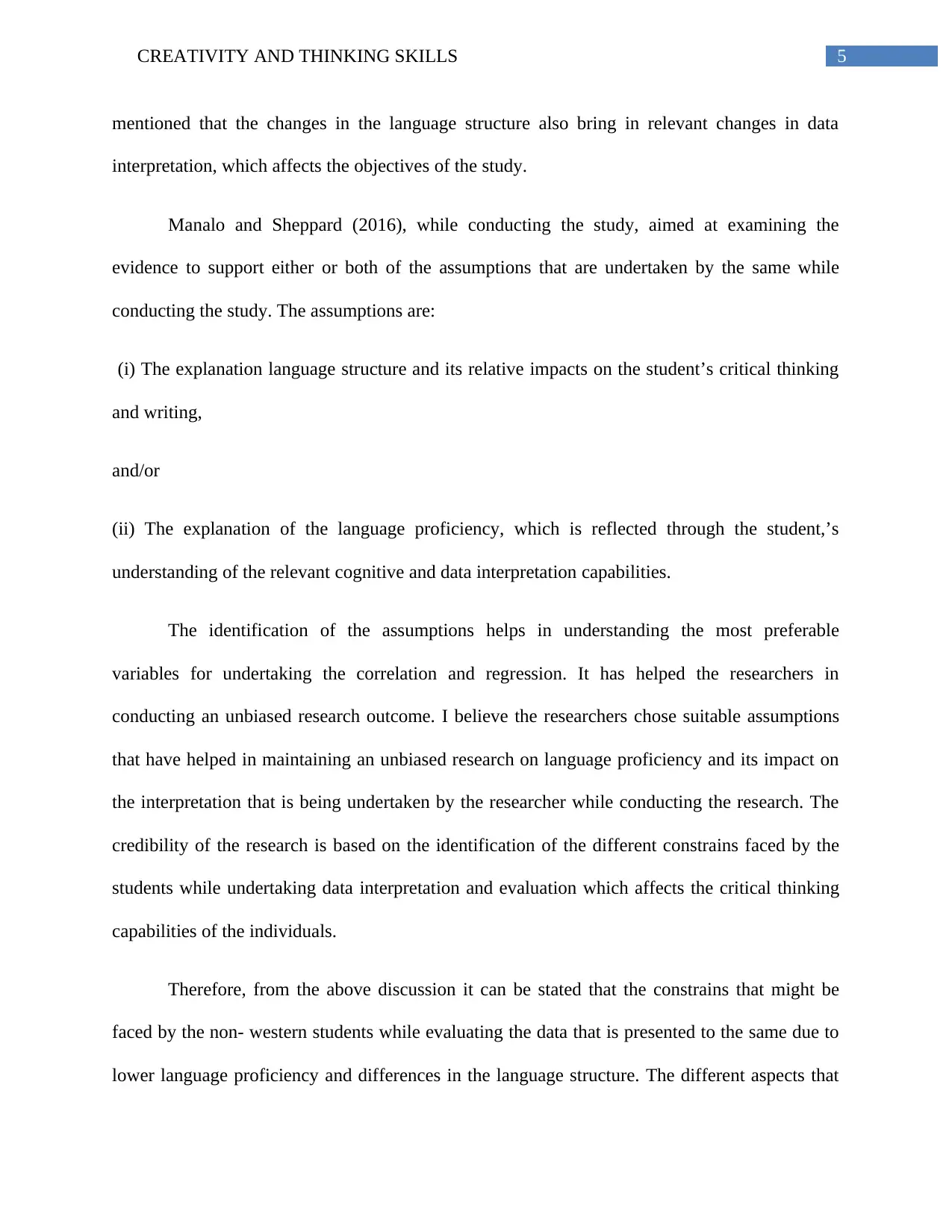
5CREATIVITY AND THINKING SKILLS
mentioned that the changes in the language structure also bring in relevant changes in data
interpretation, which affects the objectives of the study.
Manalo and Sheppard (2016), while conducting the study, aimed at examining the
evidence to support either or both of the assumptions that are undertaken by the same while
conducting the study. The assumptions are:
(i) The explanation language structure and its relative impacts on the student’s critical thinking
and writing,
and/or
(ii) The explanation of the language proficiency, which is reflected through the student,’s
understanding of the relevant cognitive and data interpretation capabilities.
The identification of the assumptions helps in understanding the most preferable
variables for undertaking the correlation and regression. It has helped the researchers in
conducting an unbiased research outcome. I believe the researchers chose suitable assumptions
that have helped in maintaining an unbiased research on language proficiency and its impact on
the interpretation that is being undertaken by the researcher while conducting the research. The
credibility of the research is based on the identification of the different constrains faced by the
students while undertaking data interpretation and evaluation which affects the critical thinking
capabilities of the individuals.
Therefore, from the above discussion it can be stated that the constrains that might be
faced by the non- western students while evaluating the data that is presented to the same due to
lower language proficiency and differences in the language structure. The different aspects that
mentioned that the changes in the language structure also bring in relevant changes in data
interpretation, which affects the objectives of the study.
Manalo and Sheppard (2016), while conducting the study, aimed at examining the
evidence to support either or both of the assumptions that are undertaken by the same while
conducting the study. The assumptions are:
(i) The explanation language structure and its relative impacts on the student’s critical thinking
and writing,
and/or
(ii) The explanation of the language proficiency, which is reflected through the student,’s
understanding of the relevant cognitive and data interpretation capabilities.
The identification of the assumptions helps in understanding the most preferable
variables for undertaking the correlation and regression. It has helped the researchers in
conducting an unbiased research outcome. I believe the researchers chose suitable assumptions
that have helped in maintaining an unbiased research on language proficiency and its impact on
the interpretation that is being undertaken by the researcher while conducting the research. The
credibility of the research is based on the identification of the different constrains faced by the
students while undertaking data interpretation and evaluation which affects the critical thinking
capabilities of the individuals.
Therefore, from the above discussion it can be stated that the constrains that might be
faced by the non- western students while evaluating the data that is presented to the same due to
lower language proficiency and differences in the language structure. The different aspects that
⊘ This is a preview!⊘
Do you want full access?
Subscribe today to unlock all pages.

Trusted by 1+ million students worldwide
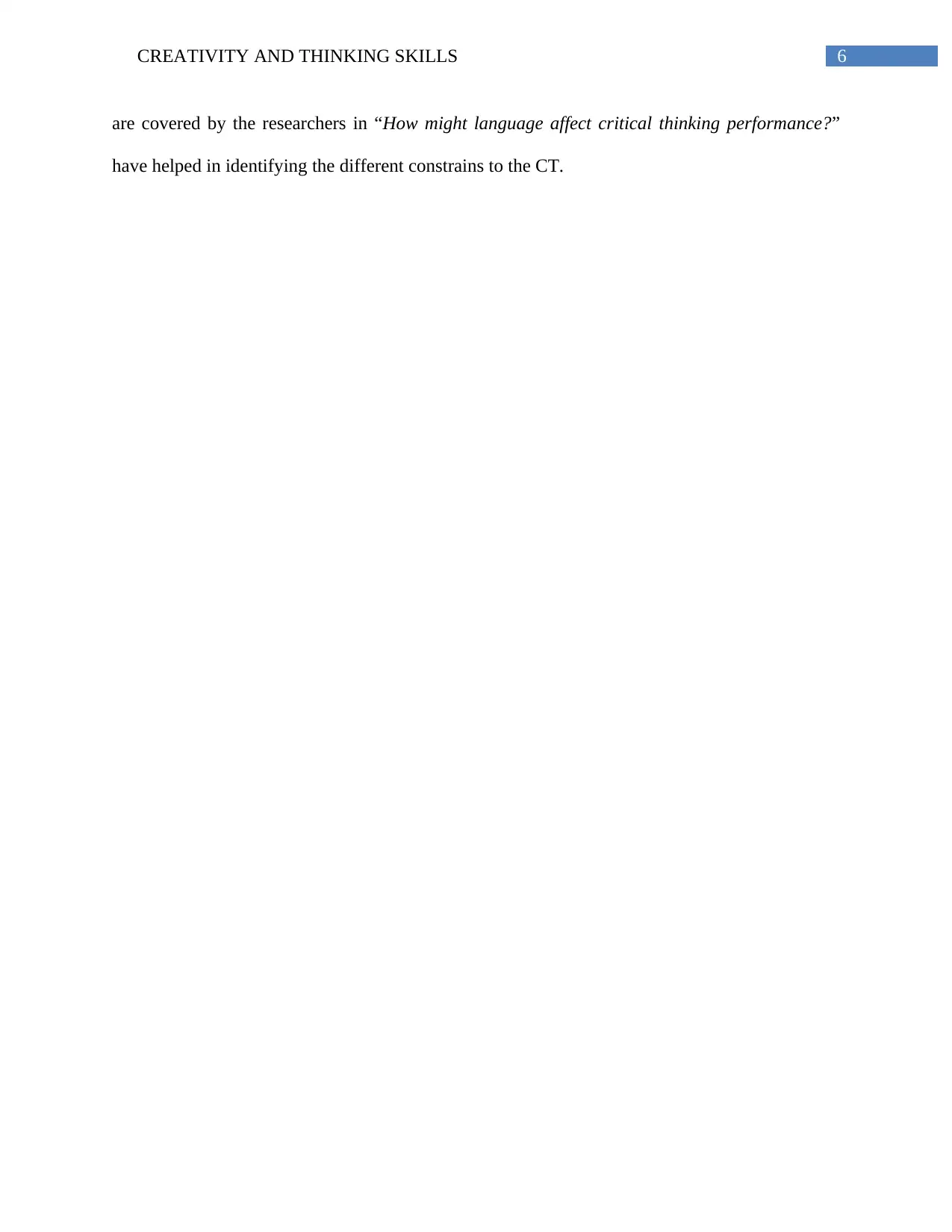
6CREATIVITY AND THINKING SKILLS
are covered by the researchers in “How might language affect critical thinking performance?”
have helped in identifying the different constrains to the CT.
are covered by the researchers in “How might language affect critical thinking performance?”
have helped in identifying the different constrains to the CT.
Paraphrase This Document
Need a fresh take? Get an instant paraphrase of this document with our AI Paraphraser
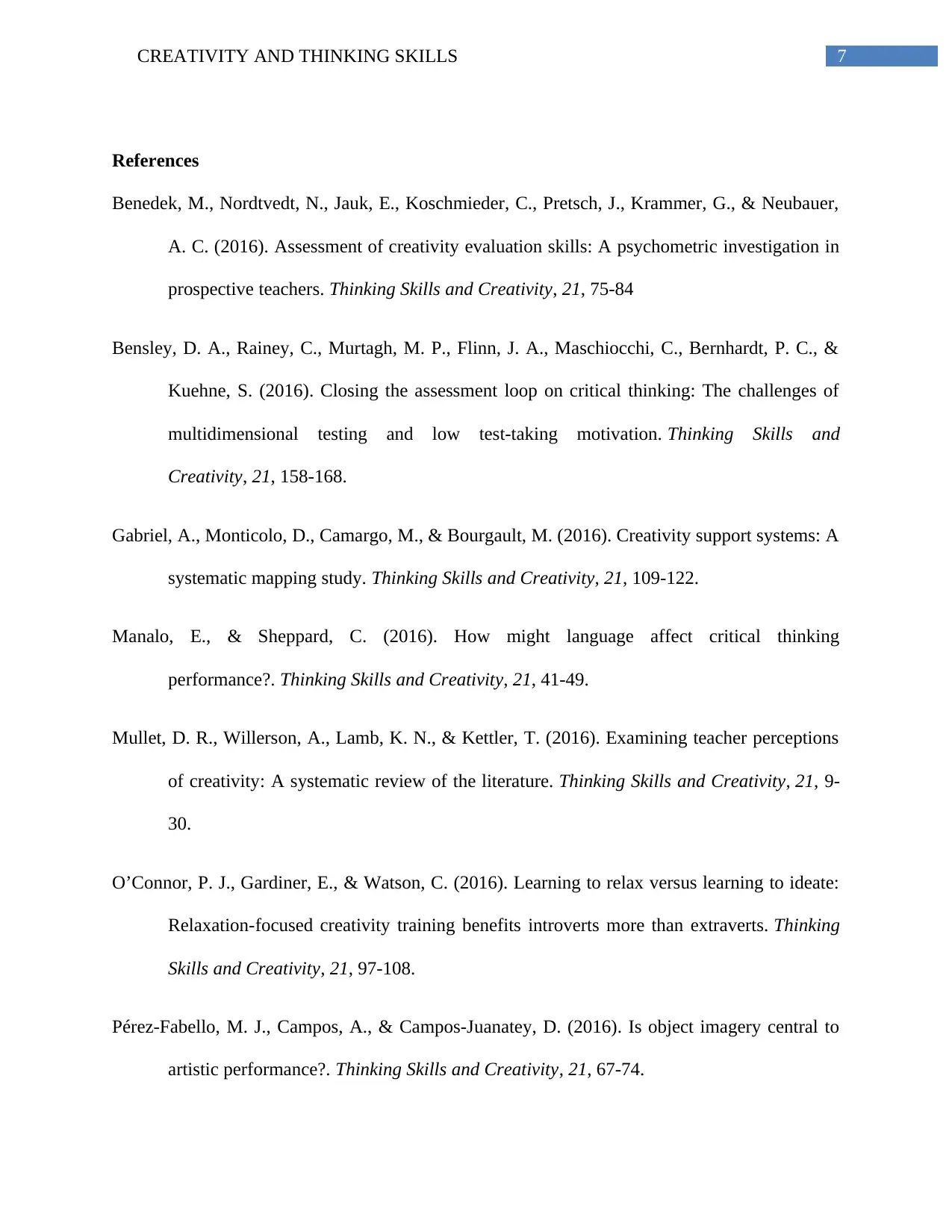
7CREATIVITY AND THINKING SKILLS
References
Benedek, M., Nordtvedt, N., Jauk, E., Koschmieder, C., Pretsch, J., Krammer, G., & Neubauer,
A. C. (2016). Assessment of creativity evaluation skills: A psychometric investigation in
prospective teachers. Thinking Skills and Creativity, 21, 75-84
Bensley, D. A., Rainey, C., Murtagh, M. P., Flinn, J. A., Maschiocchi, C., Bernhardt, P. C., &
Kuehne, S. (2016). Closing the assessment loop on critical thinking: The challenges of
multidimensional testing and low test-taking motivation. Thinking Skills and
Creativity, 21, 158-168.
Gabriel, A., Monticolo, D., Camargo, M., & Bourgault, M. (2016). Creativity support systems: A
systematic mapping study. Thinking Skills and Creativity, 21, 109-122.
Manalo, E., & Sheppard, C. (2016). How might language affect critical thinking
performance?. Thinking Skills and Creativity, 21, 41-49.
Mullet, D. R., Willerson, A., Lamb, K. N., & Kettler, T. (2016). Examining teacher perceptions
of creativity: A systematic review of the literature. Thinking Skills and Creativity, 21, 9-
30.
O’Connor, P. J., Gardiner, E., & Watson, C. (2016). Learning to relax versus learning to ideate:
Relaxation-focused creativity training benefits introverts more than extraverts. Thinking
Skills and Creativity, 21, 97-108.
Pérez-Fabello, M. J., Campos, A., & Campos-Juanatey, D. (2016). Is object imagery central to
artistic performance?. Thinking Skills and Creativity, 21, 67-74.
References
Benedek, M., Nordtvedt, N., Jauk, E., Koschmieder, C., Pretsch, J., Krammer, G., & Neubauer,
A. C. (2016). Assessment of creativity evaluation skills: A psychometric investigation in
prospective teachers. Thinking Skills and Creativity, 21, 75-84
Bensley, D. A., Rainey, C., Murtagh, M. P., Flinn, J. A., Maschiocchi, C., Bernhardt, P. C., &
Kuehne, S. (2016). Closing the assessment loop on critical thinking: The challenges of
multidimensional testing and low test-taking motivation. Thinking Skills and
Creativity, 21, 158-168.
Gabriel, A., Monticolo, D., Camargo, M., & Bourgault, M. (2016). Creativity support systems: A
systematic mapping study. Thinking Skills and Creativity, 21, 109-122.
Manalo, E., & Sheppard, C. (2016). How might language affect critical thinking
performance?. Thinking Skills and Creativity, 21, 41-49.
Mullet, D. R., Willerson, A., Lamb, K. N., & Kettler, T. (2016). Examining teacher perceptions
of creativity: A systematic review of the literature. Thinking Skills and Creativity, 21, 9-
30.
O’Connor, P. J., Gardiner, E., & Watson, C. (2016). Learning to relax versus learning to ideate:
Relaxation-focused creativity training benefits introverts more than extraverts. Thinking
Skills and Creativity, 21, 97-108.
Pérez-Fabello, M. J., Campos, A., & Campos-Juanatey, D. (2016). Is object imagery central to
artistic performance?. Thinking Skills and Creativity, 21, 67-74.
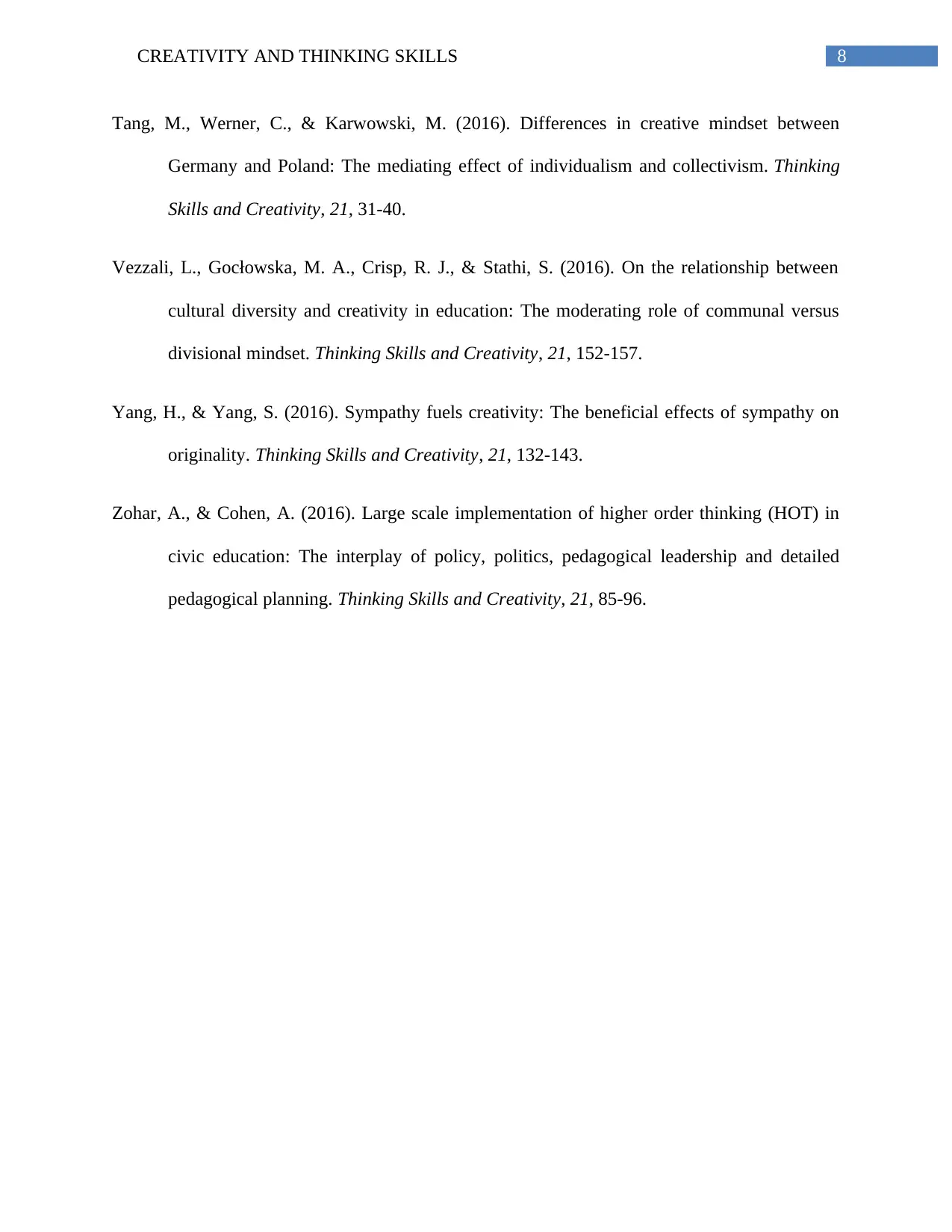
8CREATIVITY AND THINKING SKILLS
Tang, M., Werner, C., & Karwowski, M. (2016). Differences in creative mindset between
Germany and Poland: The mediating effect of individualism and collectivism. Thinking
Skills and Creativity, 21, 31-40.
Vezzali, L., Gocłowska, M. A., Crisp, R. J., & Stathi, S. (2016). On the relationship between
cultural diversity and creativity in education: The moderating role of communal versus
divisional mindset. Thinking Skills and Creativity, 21, 152-157.
Yang, H., & Yang, S. (2016). Sympathy fuels creativity: The beneficial effects of sympathy on
originality. Thinking Skills and Creativity, 21, 132-143.
Zohar, A., & Cohen, A. (2016). Large scale implementation of higher order thinking (HOT) in
civic education: The interplay of policy, politics, pedagogical leadership and detailed
pedagogical planning. Thinking Skills and Creativity, 21, 85-96.
Tang, M., Werner, C., & Karwowski, M. (2016). Differences in creative mindset between
Germany and Poland: The mediating effect of individualism and collectivism. Thinking
Skills and Creativity, 21, 31-40.
Vezzali, L., Gocłowska, M. A., Crisp, R. J., & Stathi, S. (2016). On the relationship between
cultural diversity and creativity in education: The moderating role of communal versus
divisional mindset. Thinking Skills and Creativity, 21, 152-157.
Yang, H., & Yang, S. (2016). Sympathy fuels creativity: The beneficial effects of sympathy on
originality. Thinking Skills and Creativity, 21, 132-143.
Zohar, A., & Cohen, A. (2016). Large scale implementation of higher order thinking (HOT) in
civic education: The interplay of policy, politics, pedagogical leadership and detailed
pedagogical planning. Thinking Skills and Creativity, 21, 85-96.
⊘ This is a preview!⊘
Do you want full access?
Subscribe today to unlock all pages.

Trusted by 1+ million students worldwide
1 out of 9
Related Documents
Your All-in-One AI-Powered Toolkit for Academic Success.
+13062052269
info@desklib.com
Available 24*7 on WhatsApp / Email
![[object Object]](/_next/static/media/star-bottom.7253800d.svg)
Unlock your academic potential
Copyright © 2020–2025 A2Z Services. All Rights Reserved. Developed and managed by ZUCOL.

